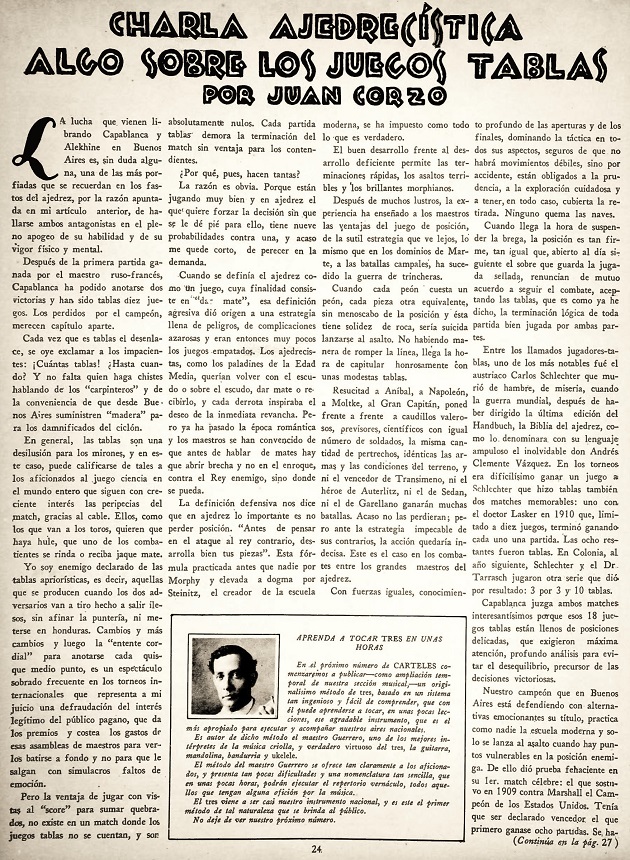Chess Notes
Edward Winter
When contacting us by e-mail, correspondents are asked to include their name and full postal address and, when providing information, to quote exact book and magazine sources. The word ‘chess’ needs to appear in the subject-line or in the message itself.
| First column | << previous | Archives [189] | next >> | Current column |
11799. A scarce monograph on Nigel Short

Nigel Short (Athens) informs us:
‘This poor-quality image is the only one that I have. It appears that the book was a games collection, Nigel Short by R.A. Ziatdinov (Tashkent, 1993), and that most of the copies were destroyed in a flood, although about 100 were sent to Turkey.’
We shall be glad to hear from any reader who has the volume.
Addition on 9 April 2020:
Reporting that he has a signed copy of the Ziatdinov book, Rudy Bloemhard (Apeldoorn, the Netherlands) has sent us a selection of images, including the following:
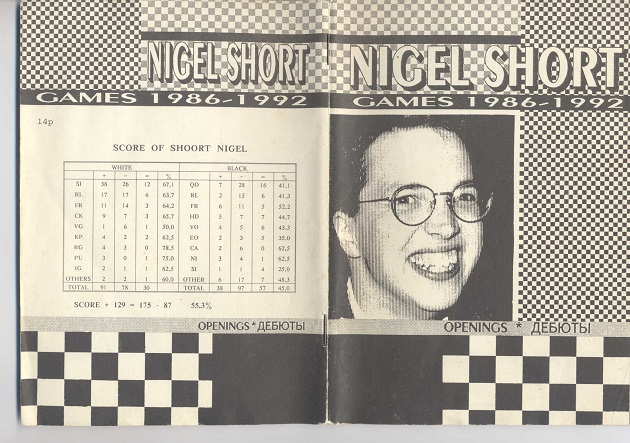

Mr Bloemhard adds:
‘There is no reference to a publisher or an ISBN number. The book, published in 1993, is 96 pages long and contains about 350 unannotated games.’
11800. Magazine references
Readers may appreciate the opportunity to follow up on some of the references in Chess Articles in Periodical Literature by Horace E. McFarland (St Louis, 1928):
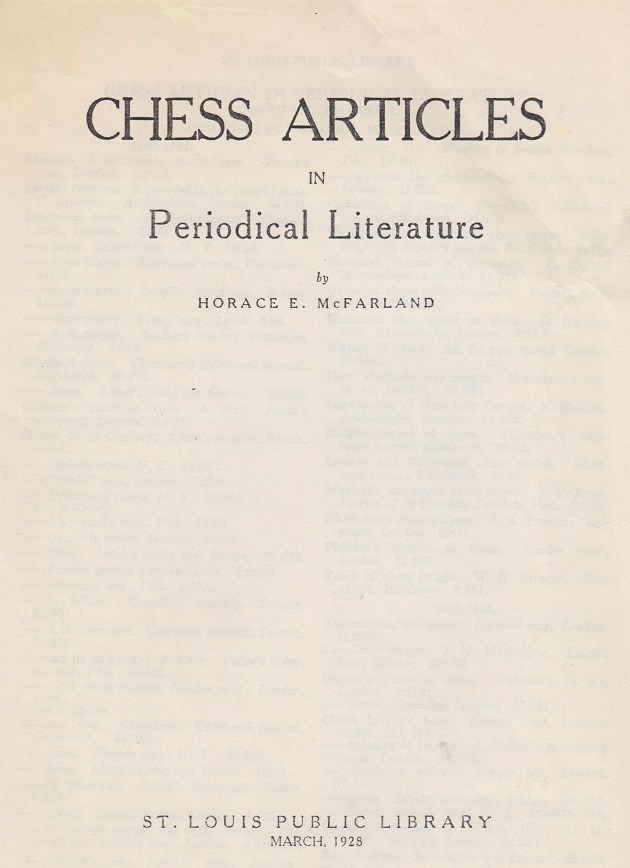
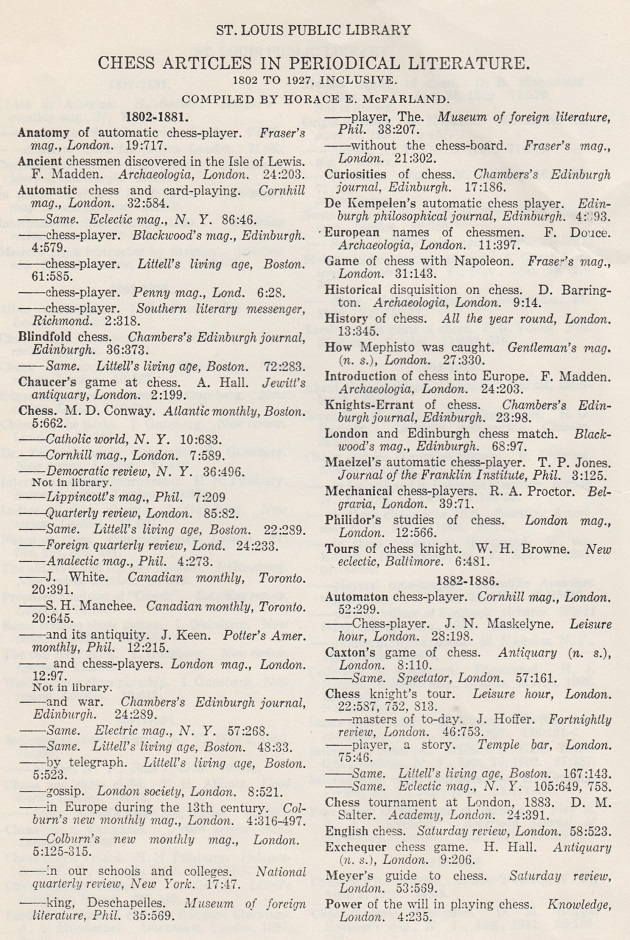
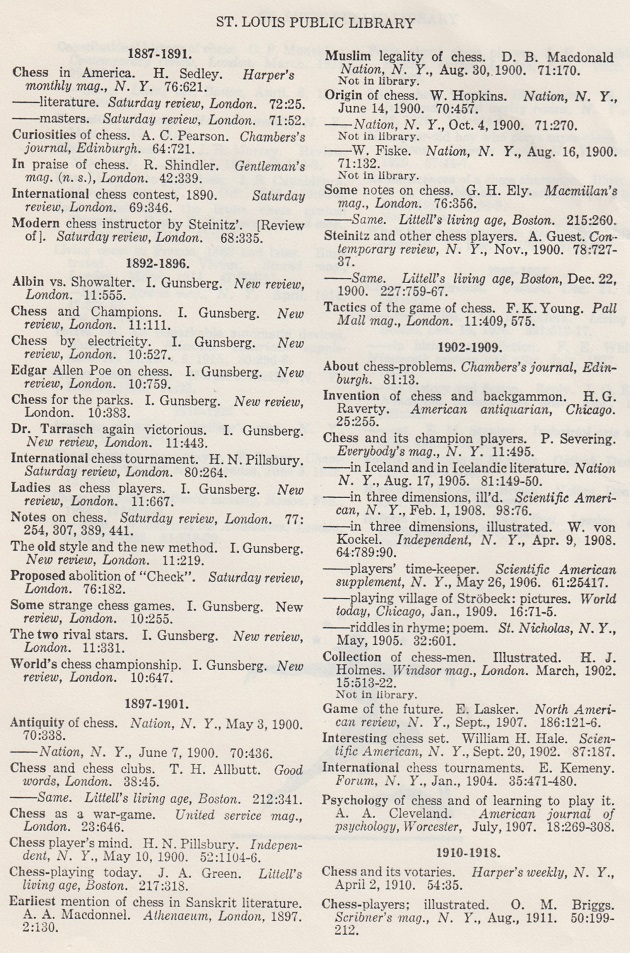
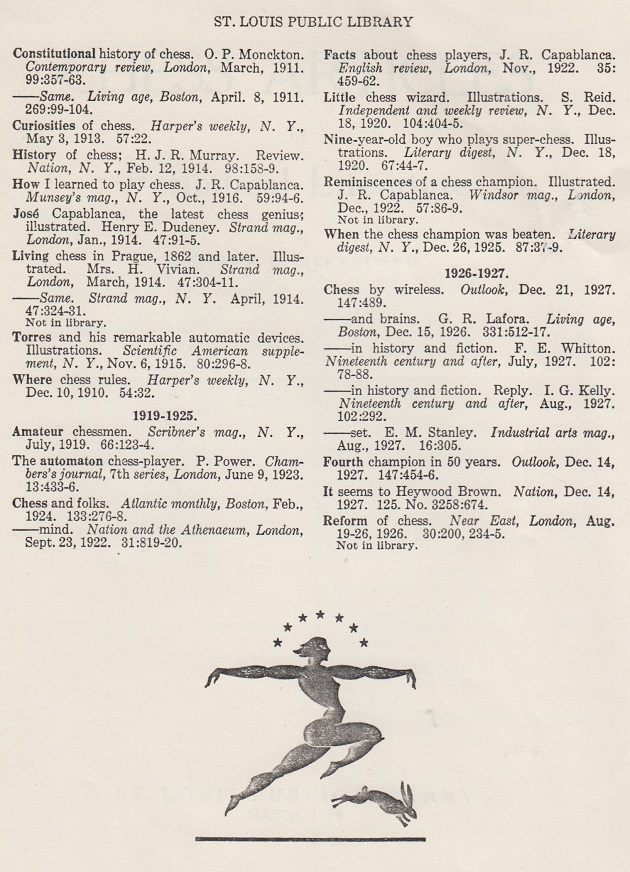
11801. Letters from Frank Skoff
A paragraph from our feature article Edge, Morphy and Staunton:
The Staunton-Morphy-Edge debate in Chess Notes continued until the magazine closed down in December 1989, and summarizing here the multiplicity of points discussed would be an impossible task. The contributions – often of outstanding quality – did not always make for easy reading, but there can be little doubt of the material’s importance for all future writers on the nineteenth-century trio. For ease of reference, the numbers of the C.N. items in the debate are: 840, 881, 943, 957, 1012, 1031, 1124, 1149, 1172, 1228, 1269, 1270, 1358, 1416, 1417, 1439, 1440, 1480, 1499, 1569, 1570, 1633, 1642, 1643, 1669, 1700, 1722, 1757, 1758, 1818 and 1932. Moreover, Skoff submitted a 16-page letter dated 17 November 1989 which arrived too late to be included in the final issue of the magazine; copies were made available upon request to interested readers.
Frank Skoff fully accepted that procedure.
Now, we give his 16-page letter as a PDF file, together with a one-page follow-up letter which he wrote on 20 November 1989 after seeing a preview of a comment by us in C.N. 1932.
Not all the C.N. items listed above are on-line, which means that parts of Frank Skoff’s letters will be unclear. However, there is no lack of clarity in his overall stance: strong criticism of certain British chess writers for inaccuracy and bias over the Edge-Morphy-Staunton controversy, with Kenneth Whyld singled out for excoriation.
11802. The Duke of Wellington
From John Townsend (Wokingham, England):
‘In an article entitled “Celebrated Chess-Players”, reproduced from the Chess Record, page 30 of the January 1880 American Chess Journal had the following:
“The Duke of Wellington was a chessplayer of more than the moderate skill of his great rival, Napoleon.”
Howard Staunton had replied to a correspondent as follows in the Illustrated London News, 29 March 1845, page 208:
The Iron Duke had been a subscriber to William Greenwood Walker’s A selection of games of chess, actually played in London, by the late Alexander McDonnell ... (London, 1836), his name being listed as such on page 279.’
Can anything be added regarding the Duke of Wellington’s chess activities?’
11803. The Club Capablanca, Havana
Below are two photographs of the Club Capablanca (calle Infanta 54, Havana) taken by Bernardo Alonso García, the copyright owner, and sent to us in 1994 by Armando Alonso Lorenzo (Prov. Ciego de Avila, Cuba):


11804. H.J.R. Murray’s books
We have a copy of a 19-page typescript by H.J.R. Murray dated 1940, ‘My Chess Books, etc.’:
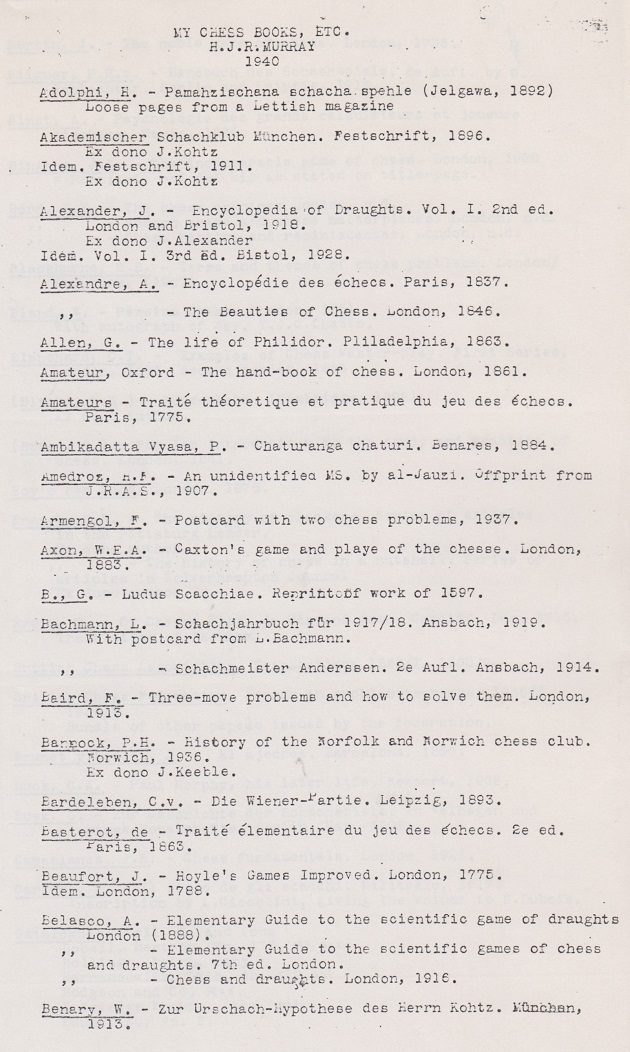
11805. A projected book on the Polgar sisters
A two-page letter to us from Rogelio Caparrós (Elizabeth, NJ, USA) dated 2 January 1992 was chiefly about his planned book on Alekhine but included one paragraph on another project:
‘I have already finished a collection of 432 games of the Polgar sisters, with a diagram per game. Some diagrams have been inserted at the crucial points, replacing to a certain point an annotation.’
He gave a sample page of the intended work, which was entitled Las Maravillosas hermanitas Polgar:
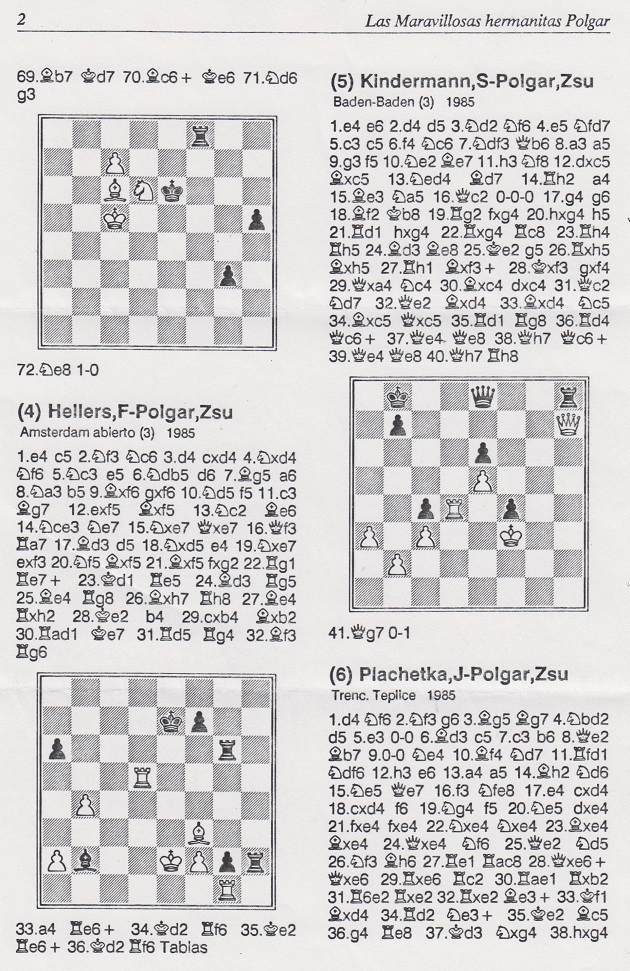
11806. 1 Nf3 d5 2 b4 f6
On the subject of chess punctuation, three exclamation marks at move two were awarded by Reuben Fine on page 58 of Chess Marches On! (New York, 1945):
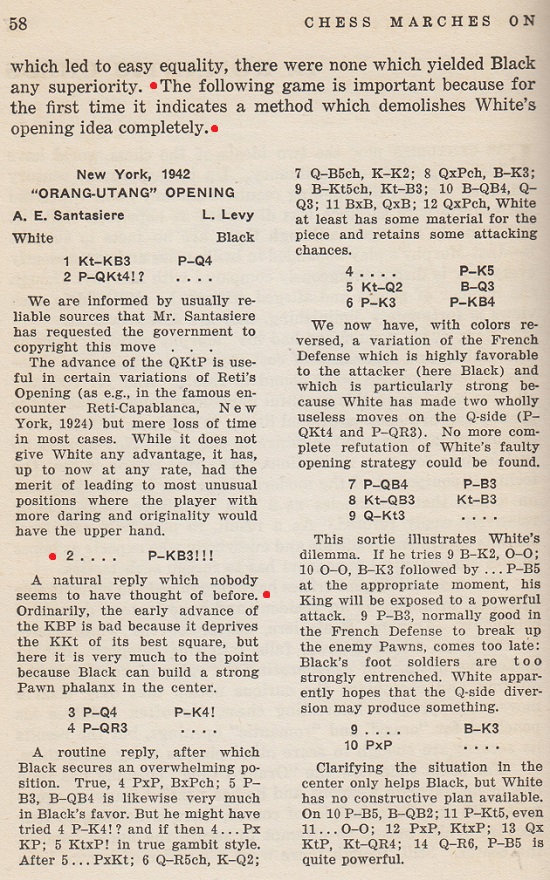
When Fine’s annotations had appeared on pages 8-10 of the January 1942 Chess Review, 2...f6 received only two exclamation marks.
The date ‘1942’ is an error. Eduardo Bauzá Mercére (New York, NY, USA) notes this report on page 17 of the Brooklyn Daily Eagle, 15 December 1941:
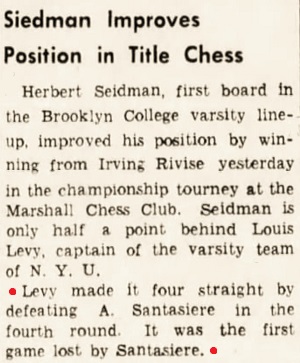
Fine was also incorrect to state that nobody seemed to have thought of 2...f6 before Levy played it in that game. Databases have a loss by Santasiere to Harry Fajans, which, Mr Bauzá Mercére points out, was annotated by Santasiere on page 14 of the January-February 1941 American Chess Bulletin:
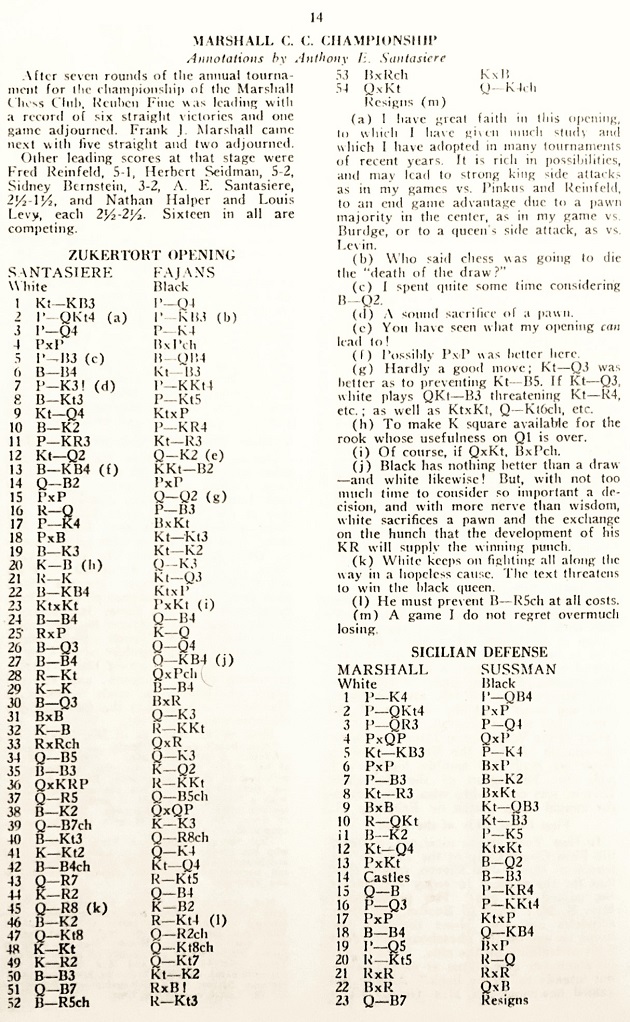
Our correspondent adds that a report on the tournament, the Marshall Chess Club Championship, on page 21 of the New York Times, 13 January 1941 recorded that the Santasiere v Fajans game had been adjourned. He refers too to page 195 of the October 1942 Chess Review, where Edward Lasker annotated a win over Santasiere with 2...f6 in the New York State Championship in Cazenovia, August 1942. The first note mentioned Fine’s January 1942 article.
11807. Capablanca’s US education (C.N. 6378)
An advertisement on page 16 of the South Orange Record, 22 April 1903:
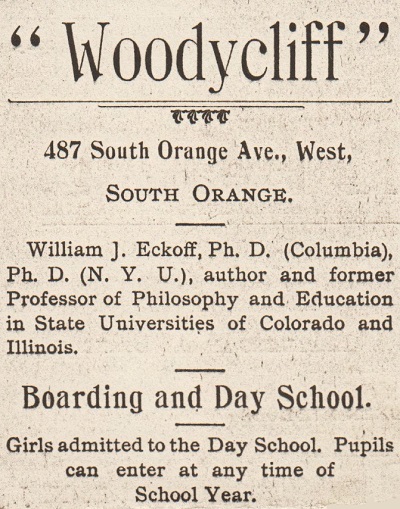
11808. Drawings of Capablanca and Alekhine
Page 3 of Crítica, 17 September 1927:
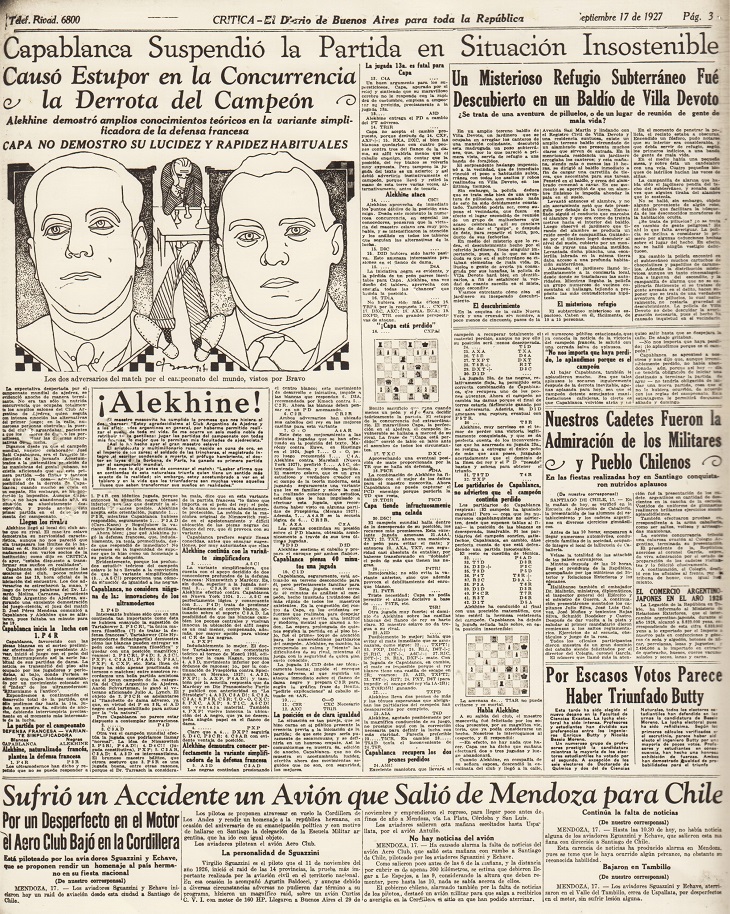
11809. The Duke of Wellington (C.N. 11802)
Jerry Spinrad (Nashville, TN, USA) forwards this cutting from page 2 of Bell’s Life in London, 19 March 1837:
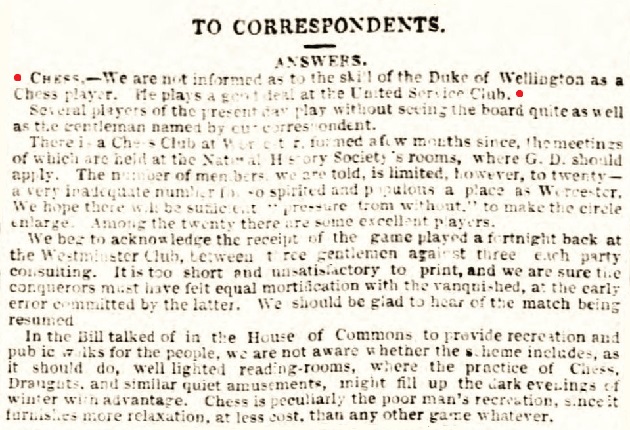
The final, general sentence is notable:
‘Chess is peculiarly the poor man’s recreation, since it furnishes more relaxation, at less cost, than any other game whatever.’
11810. Staunton Street
Mr Spinrad also sends, on the topic of Street Names with Chess Connections, a lengthy report on page 5 of Lloyd’s Weekly London Newspaper, 21 December 1856 which suggested, ten lines from the bottom of the second column, that a London street be named after Howard Staunton.
London does indeed have a Staunton Street, but since when?
11811. Vienna, 1922 poster
C.N. 6369 mentioned that many chess-related images are available at the website of the Österreichische Nationalbibliothek in Vienna.
Further to C.N. 11725, which referred to Hans Kmoch’s brother Ladislaus, James Bell Cooper (Vienna) notes that the Library has a poster by L. Kmoch on the Vienna, 1922 tournament:
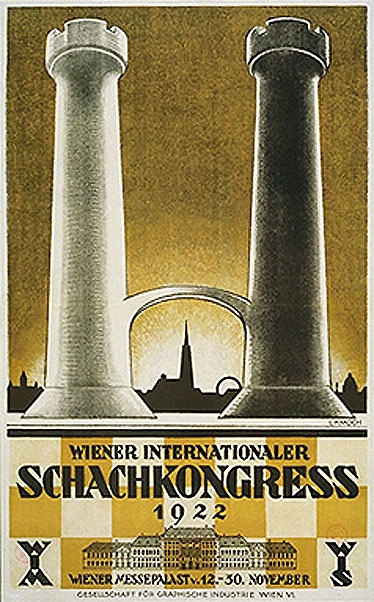
11812. Rafael Blanco (C.N.s 3471 & 3475)
It will be appreciated if a reader can provide a good-quality version of an article by Bernardo G. Barros about the chessplayer and artist Rafael Blanco on pages 455-456 of the Cuban magazine El Fígaro, 1911. We have only a faint photostat:
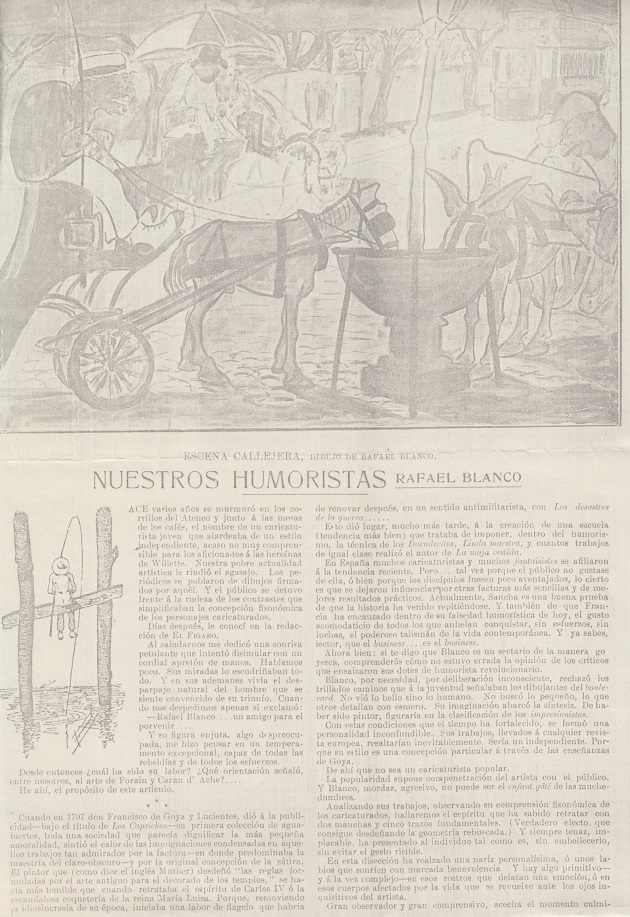
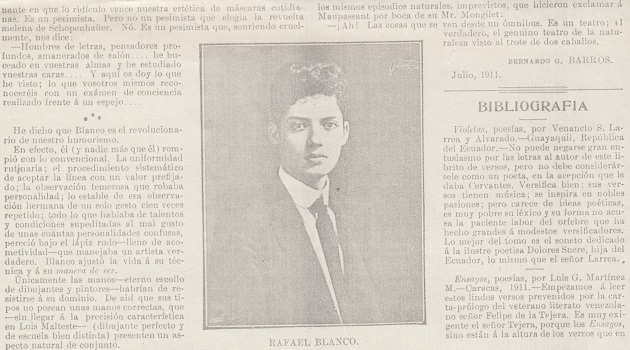
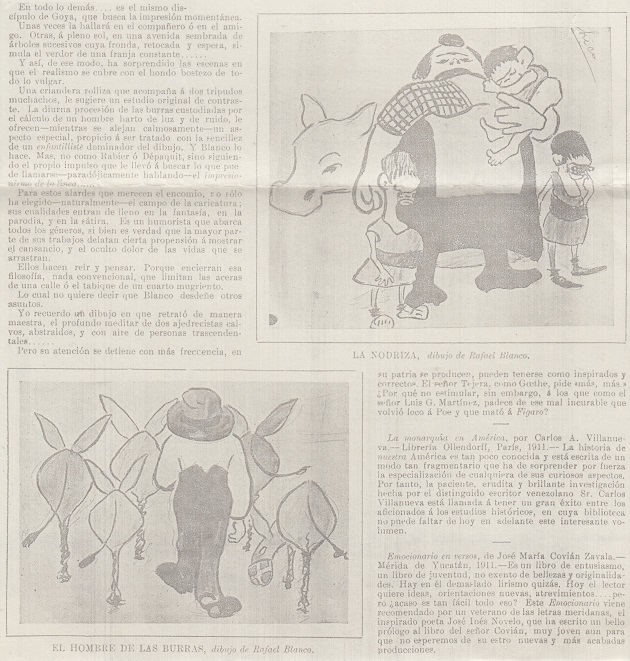
11813. Capablanca film (C.N.s 1484, 3986 & 4303)
The carelessly-produced video-cassette case:
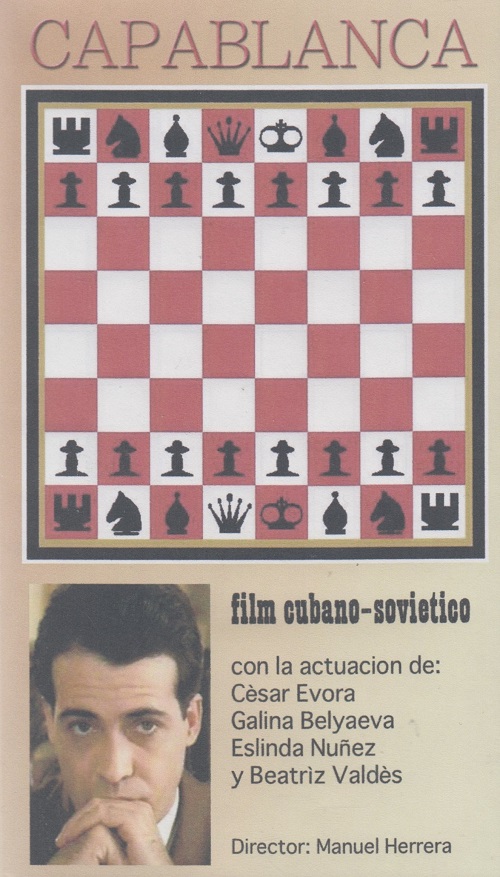

Below is a photograph reproduced from a full-page article about the film on page 9 of the Cuban newspaper Juventud Rebelde, 6 March 1988:
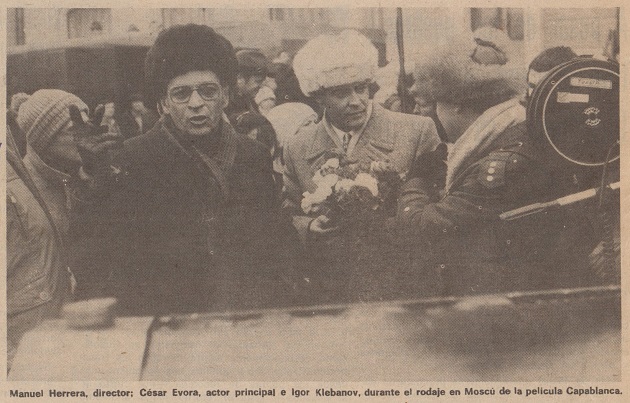
11814. Emanuel Lasker
Just received: volume two of Emanuel Lasker edited by Richard Forster, Michael Negele and Raj Tischbierek (Berlin, 2020):
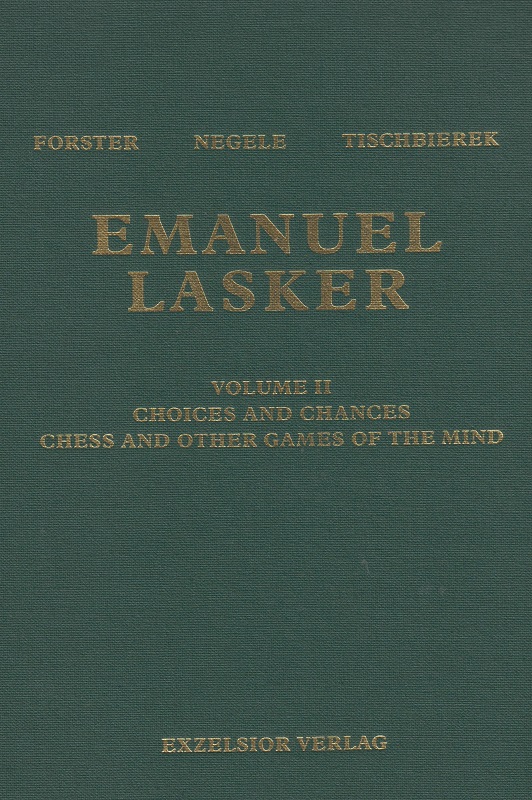
The publisher’s webpage presents an extract from this superb volume, as well as ordering details; the book will also be obtainable from McFarland & Company, Inc. Information about volume one (2018) and the 2009 German-language tome is given in our feature article.
From the private archive of Christian Wohlfarth (Berlin) we reproduce with the Editors’ permission a photograph of Lasker playing Go which is on page 164 of volume two:
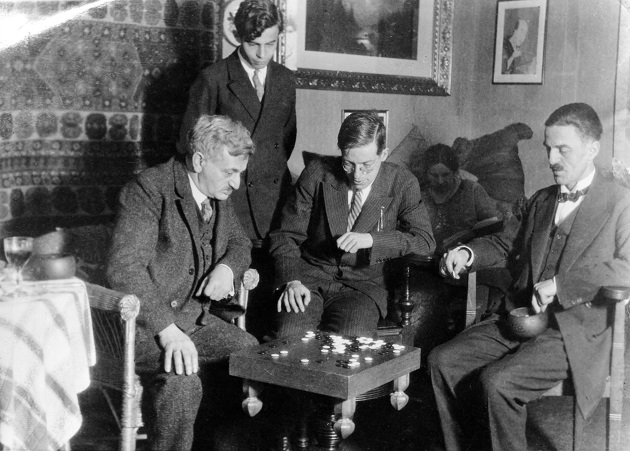
The caption states that Lasker’s opponent was Felix Dueball, at whose residence the picture was taken on 7 March 1930. His eldest son Fritz is standing, and the man seated in the centre is Kurt Rosenwald.
11815. The Daily Mirror

A new feature article has just been posted: Chess Photographs in the Daily Mirror.
11816. Samuel Reshevsky
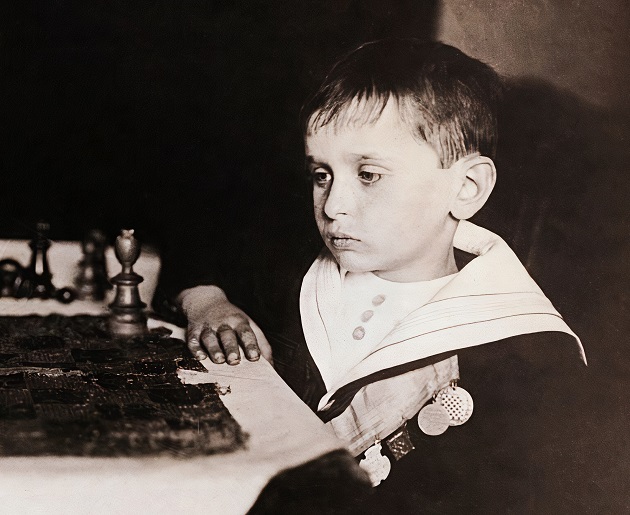
The early years of Samuel Reshevsky are the subject of our latest feature article.
11817. An interview with Lim Kok Ann
There follows an interview by Giam Choo Kwee with Lim Kok Ann which the latter sent us in September 1986:
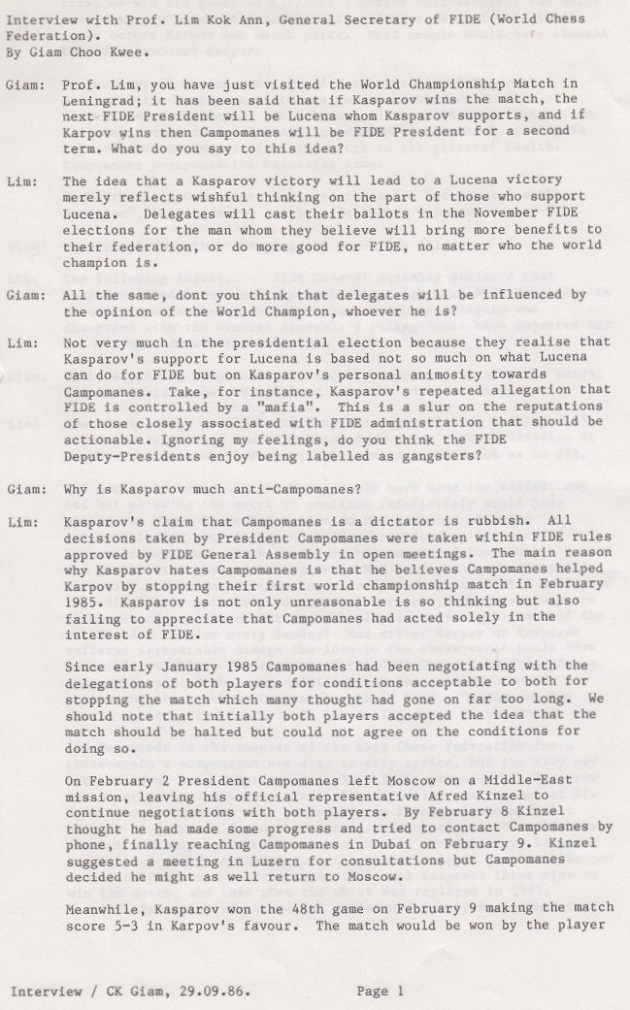

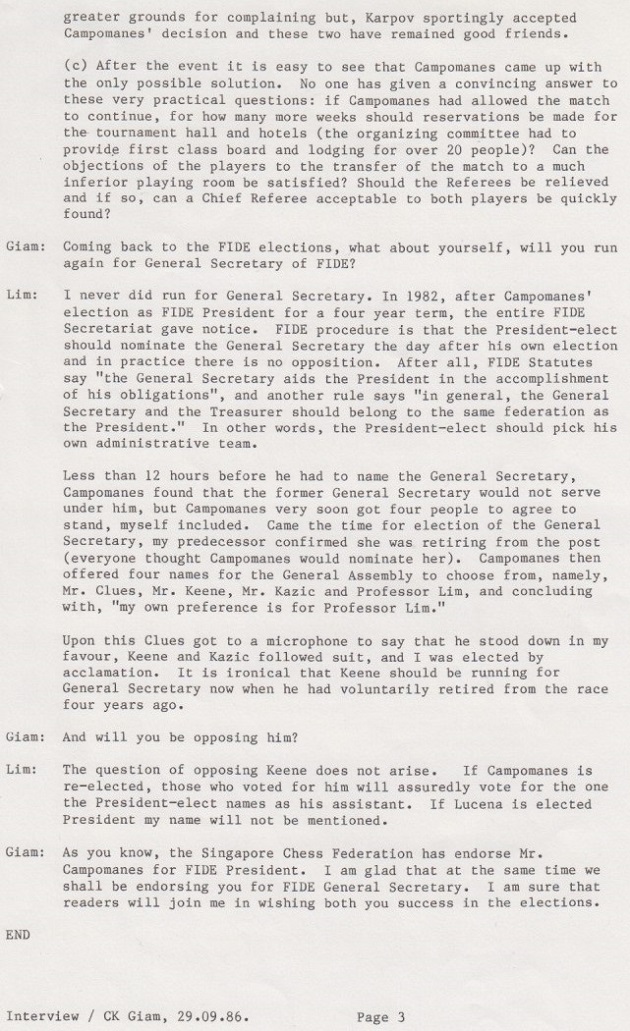
This 1968 photograph of Giam Choo Kwee and Lim Kok Ann comes from the private archives of Choong Liong On and is reproduced courtesy of Olimpiu G. Urcan (Singapore):
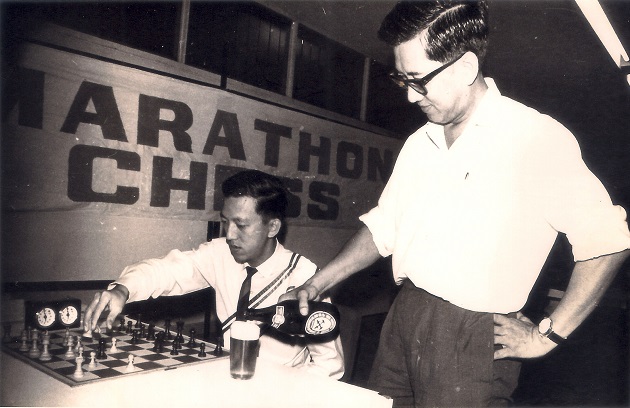
Regarding the picture, see too page 99 of the book Singapore Chess (C.N. 10567).
11818. R.N. Coles
C.N. 10455 included an autobiographical summary which R.N. Coles sent us on 4 April 1979, and here we add a biographical note by his brother Jack which was forwarded by Graham Smith (Guildford, England) on 28 September 1983:
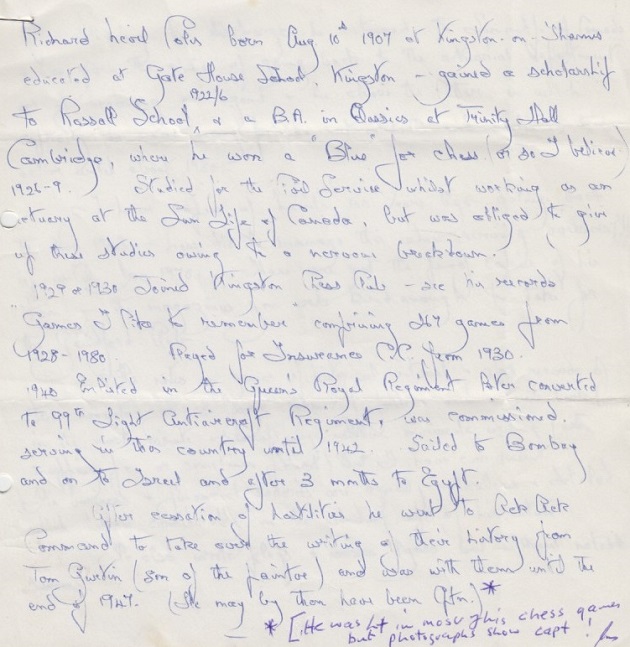
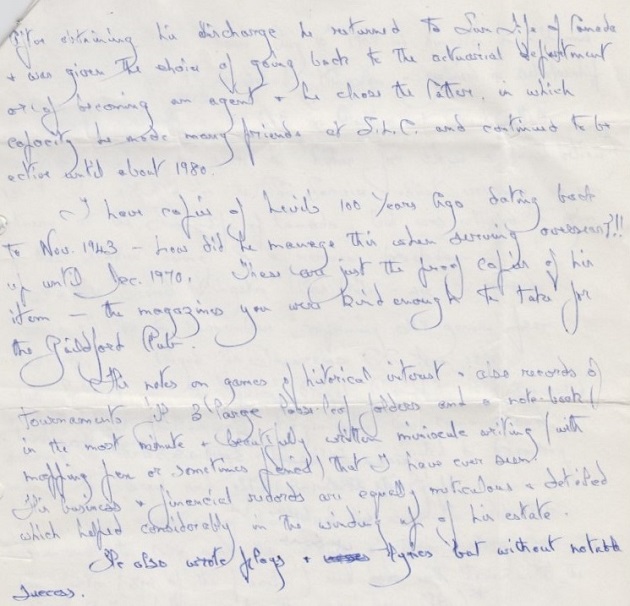
11819. A quiz question
Name the person who has written all the following:
- on his website, a brief review of Kings, Commoners and Knaves which said little about our book but suggested, with no particulars, that we were ‘starting to draw up a hit-list’, that we might be sued for libel by Raymond Keene, and that our reputation was for ‘objectivity (bordering on pedantry)’;
(In his magazine he published a different version of the review, but still with only one specific reference to our book’s contents: ‘The “Knaves” of his title would seem to include Ray Keene and Eric Schiller but I had to smile at his exposure of the latter’s cheap and unfounded remark about one of my books in the item on page 271.’)
- on a dedicated webpage, an attempt at personal mockery of us through pictorial ‘Austin Winters’ items (a spoof of the first Austin Powers film). They were soon withdrawn;
- on his website, a review of an issue of the magazine Kingpin, with about one-third of the entire review consisting of muddled comments about our having a Forum in Kingpin while also writing the C.N. column. The Forum ...
‘... looks very like Chess Notes, especially the (I won’t say undeserved) attacks on Ray Keene and Eric Schiller without which no article by Edward Winter would these days be complete. I am far from defending the hack-work of these guys but it is making Winter sound like a vinyl LP stuck in a groove. I also see that he is at the same lark on the Inside Chess website’;
(The above ignored, inter alia, the fact that in a personal message we had already told him regarding Raymond Keene: ‘I invite you to note how often his name has even been mentioned in C.N. since my column began in New in Chess about a year and a half ago. Answer: not once.’ Further details will be provided in due course on this point, and all the others in the present C.N. item.)
- on a correspondence chess website, the untrue pronouncement that we had been sacked as a Chess Café columnist;
- in an on-line column, this assessment of C.N.:
‘The kind of historical-biographical chess writing which essentially consists of snippets (even if they are arranged into “threads”) cannot in the end make any great contribution to chess history, consisting as it largely does of minor corrections to the record, a bit of debunking, a lot of hobby-horse-riding, some settling of scores and the occasional answer to readers’ questions’;
- in a publication, a claim that ‘the piecemeal work of Edward Winter, whose column “Chess Notes” has transferred to web publication, is chiefly reliant on editing readers’ input’;
- in correspondence with another chess historian, these statements: ‘I am unwilling to use Edward Winter’s column as a conduit of information because he never gives me any credit for data that I have occasionally supplied in response to his queries, nor does he mention my books if he can help it.’ The correspondence contained no corroboration of these statements about us, which are untrue;
- on a discussion forum, two posts about Eric Schiller, again referring to page 271 of Kings, Commoners and Knaves. The posts included the following: ‘the Winter article (and usually I don’t agree with Winter) is right on the money about Schiller’s carelessness when it came to his so-called literary efforts which are mostly of little merit’ and ‘I knew immediately that what Schiller wrote was a disgraceful and intellectually dishonest lie. Nothing since ever caused me to change my mind about him.’ Our own ‘page 271 criticism’ of Eric Schiller was written in 1993; the two posts on the discussion forum (obituary section) were written just a few days after Eric Schiller’s death;
- in one of his books, a declaration that C.N. ‘benefits from a network of contributors worldwide, happy to do so in exchange for having their books promoted or just “seeing their name up in lights”’;
- on the same page of that book, an observation that C.N. ‘does not engage in systematic research of the kind this author believes should be the main aim of a chess historian’, and that ‘the world of the chess historian would be well served if Mr Winter decided to return to the production of major contributions to chess literature’, as opposed to C.N.;
- on a discussion forum, this assertion (on 15 September 2020): ‘I haven’t for many years contributed to Chess Notes because of Winter’s many and unfair attacks on my work.’ Persistently challenged on the forum to substantiate those words, he remained silent.
Addition on 30 October 2020: Answer.
11820. C.N.
One or two new feature articles are in the pipeline, and further batches of C.N. items will also be posted shortly. Over the past four months, material has been added direct to about 250 feature articles.
We no longer sell books or magazines, but items from our collection can be acquired from two respected international dealers: SchachSchneider and Antiquariat A. Klittich.
11821. Alessandro Sanvito (1938-2020)
Following the recent death of Alessandro Sanvito, one of the chess world’s most highly-respected historians, an excellent account of his bibliographies of Italian chess literature has just been posted on Michael Clapham’s Chess Book Chats website.
11822. Small chess sets
New editions of the book Guinness World Records are no longer monitored here but, as mentioned in C.N. 11540, the Guinness company has a database which includes many chess-related exploits. One of them, dated 2020, is headed ‘Smallest handmade chess set’.
For purposes of comparison, below is C.N. 377 (written in 1983):
A report in the Tribune de Genève of 1 February 1983 says that five students at the Ecole d’ingénieur de Genève (Philippe Cantin, Jean-Marie Croisier, Robertino Noventa, David Ribaut and Marc Schmidt) have made what is thought to be the smallest chess set in the world. The peg-in board measures 8 mm by 8 mm; the size including the border frame is 12 mm x 12 mm. Each square is 1 square mm, the pawns are 1.5 mm high, while the tallest piece, the king, measures 2.5 mm. An actual game can be played with it. Four hundred hours of work went into it, and the Livre des records is now doing its research to try to establish whether this is indeed a world record.
The chess set was referred to on the front page of the Geneva newspaper, and the detailed report, by Jean-Noël Cuénod, was on page 9:
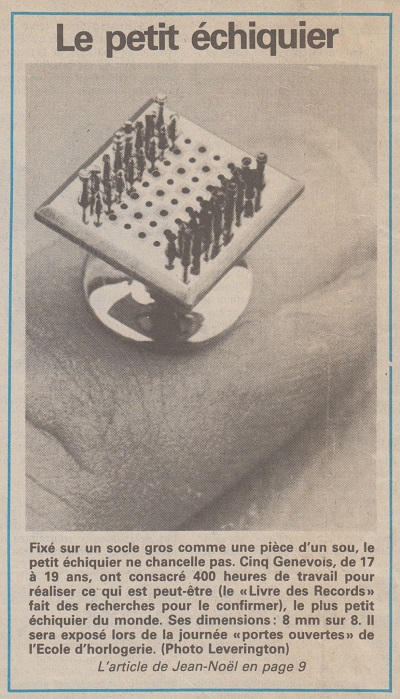
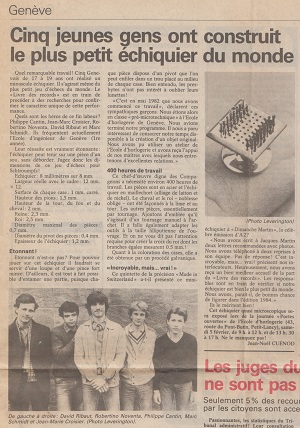
11823. Harry Golombek (1911-95)
Golombek’s English-language Wikipedia entry currently gives Lambeth as his place of birth and death. In the Oxford Dictionary of National Biography (an entry written two decades ago by Professor William D. Rubinstein) a precise address in the London Borough of Lambeth was supplied for his birth: 200 Railton Road, Brixton. The Dictionary also specified that Golombek died in the Dawn House residential home, South Park Crescent, Gerrards Cross, Buckinghamshire.
Below is a paragraph from a letter that Golombek wrote us on 26 February 1972:

11824. Harry Golombek (C.N. 11823)
From John Townsend (Wokingham, England):
‘The address of Harry Golombek’s birth, as quoted from the Oxford Dictionary of National Biography, is slightly different from that of the Golombek family home listed in the 1911 census, when H.G.’s age was given as one month. The census entry (National Archives, RG 14 2098) was written and signed by the chessplayer’s father, Barnet Golombek, a 33-year-old dealer in gas fittings, who was recorded as being of Russian nationality and born at Zambrov [sic]. The address specified was 200 B, Railton Road, Herne Hill, [London], S.E., and the census shows that 200 Railton Road was a separate household.
H.G.’s mother, Emma, was also stated to be of Russian nationality, and there were two other children, Abraham and Rosy.’
11825. Kings of the Castle
A programme not yet mentioned in Chess and Television is Kings of the Castle, narrated by Paul Jennings, produced by Robert Toner and broadcast on BBC-2 on 22 July 1978. We have this BBC Enterprises flyer:
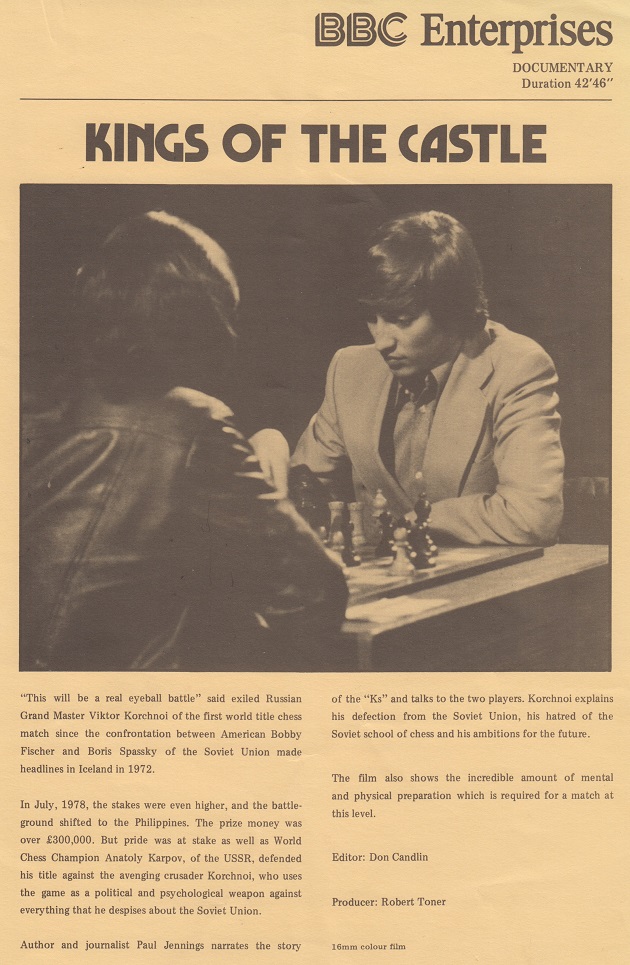
Three years later, on 3 October 1981, a documentary of the same title was transmitted by BBC-2 ahead of the world championship match in Merano.
11826. Réti’s loss to Alekhine (C.N. 2681)
As it would not otherwise be on-line, C.N. 2681, from July 2002, is reproduced here:
Pages 89-90 of L’Echiquier, May 1926 gave the game Alekhine v Réti, Semmering, 1926. Our copy is inscribed in ink by Réti, who added in pencil three proposed improvements to his play: 8…Kh7, 15…a5 and 21…f5. Only the second of these suggestions was mentioned in Alekhine’s On the Road to the World Championship 1923-1927.
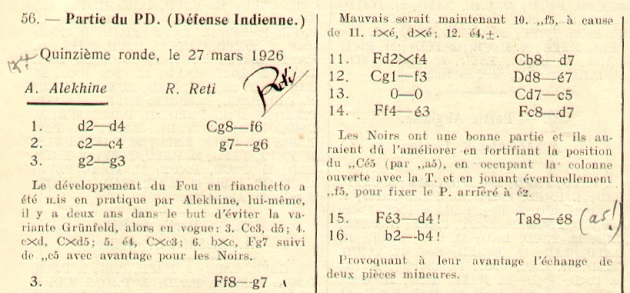
11827. Problemists’ inscriptions

The above was sent to us on 14 April 1984 by Robert Sinnott (Norwell, MA, USA), who wrote:
‘It is a copy of Schuster’s Problems (L/N 2588) which he presented to Sam Gold (L/N 2458) with an inscription in Hungarian. Dr Gold subsequently passed the book along to Otto Wurzburg (L/N 2727) with his inscription in English. So now we have three problemists involved in the same book.’
He added that in 1972 Alice Loranth of the Cleveland Public Library gave him a translation of Zsigmond Schuster’s Hungarian text:
‘Honorable
To Dr Sam Gold, to my enthusiastic and esteemed comrade, to the outstanding problemist of our country, as a token of my gratitude, unlimited admiration and highest esteem.’
11828. Inscribed books
Notwithstanding the first paragraph of C.N. 11820, some inscribed copies of our books are still available.
11829. Articles by Juan Corzo
Three articles by Juan Corzo y Príncipe about the 1927 world championship match have been given from Carteles: 9 October 1927, page 17 (C.N. 11260); 20 November 1927, page 24 (C.N. 11271); 18 December 1927, page 25 (C.N. 11271).
Now, Yandy Rojas Barrios (Cárdenas, Cuba) has submitted a fourth one, on pages 24 and 27 of the Cuban magazine’s 23 October 1927 edition:
Our Cuban correspondent has also provided 16 articles by Corzo which Carteles published between 28 November 1937 and 4 December 1938. They are being added direct to our feature article Immortal but Unknown.
11830. A Tartakower remark
On 22 April 1997 Mark Saylor, an editor at the Los Angeles Times, asked whether we had a source for a quote attributed, he believed, to Tartakower:
‘Chess ennobles man, for it is filled with disappointment.’
Nothing was found, but now Richard Forster (Winterthur, Switzerland) notes that the remark (‘Das Schachspiel veredelt den Menschen, da es voller Enttäuschungen ist’) was the fourth in a list of observations by Tartakower on pages 353-355 of the December 1927 Deutsche Schachzeitung:
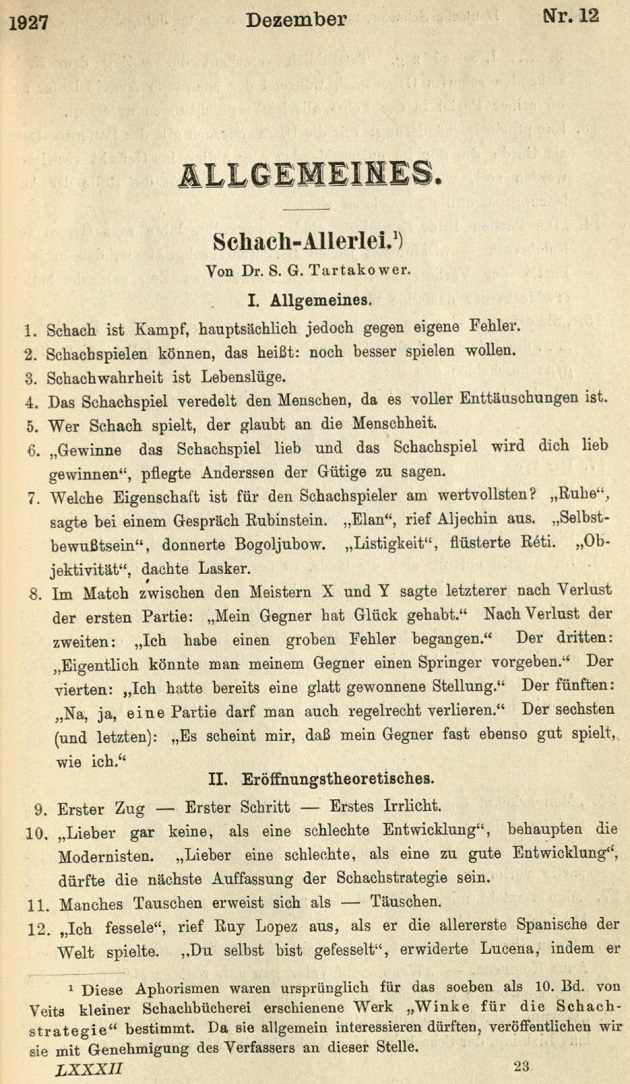
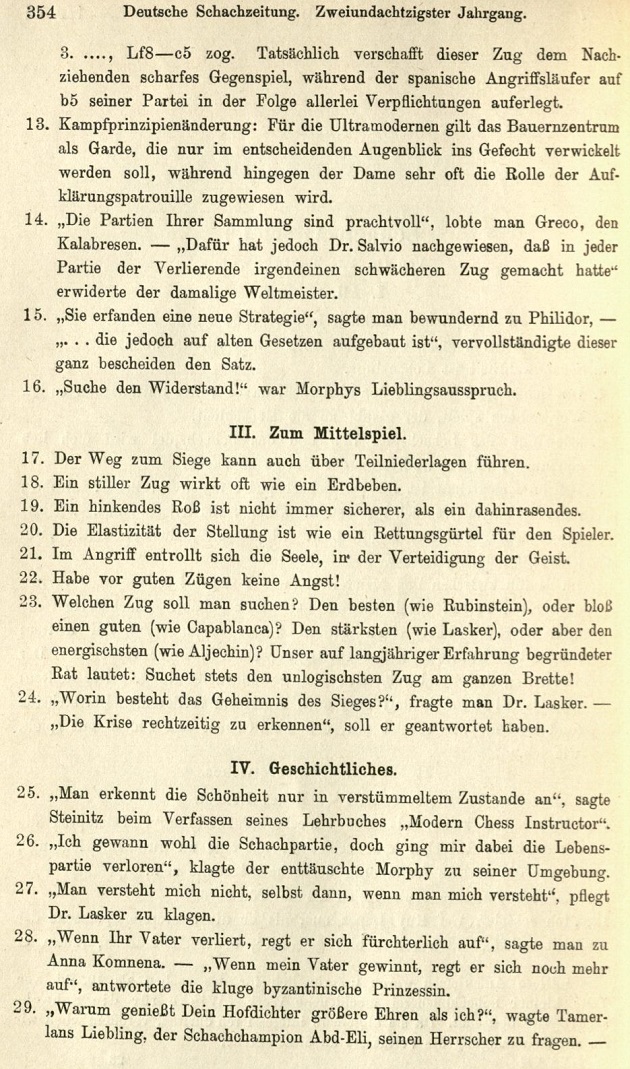

Acknowledgement for the above scans: the Cleveland Public Library.
11831. A lecture by Pal Benko
Continuing to browse through old correspondence files, we see a letter dated 26 September 1988 from George Stern (Woden, Australia), He enclosed his chess column on page 14 of the Canberra Times, 17 March 1985, featuring ‘a capsule autobiography of Pal Benko, which I recorded when he was in Canberra in 1985’:
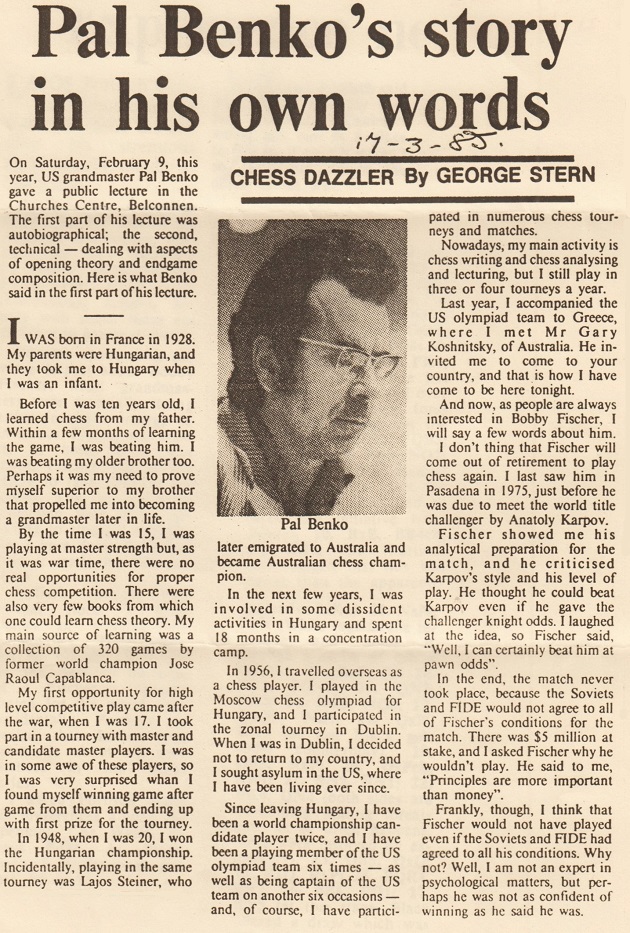
We have shown the column to John Donaldson (Berkeley, CA, USA), who comments:
‘This is an interesting article, albeit with several inaccuracies. It is possible that Benko’s memory betrayed him, but much more likely that the reporter got the details wrong.
It appears to violate Fischer’s dictum that friends not speak about him to the press. Benko was a faithful adherent to this rule, which partly explains why he and Fischer remained friends until the end of Fischer’s life.
The probable explanation for Benko making an exception is that at the time of the lecture he had not been in contact with Fischer since the late 1970s and likely thought he never would be in contact again.
Material which David DeLucia has shared in his books makes it clear that Fischer’s correspondence with Benko and Gligorić stopped around 1978 and did not resume until the early 1990s. Benko in 1985 had no way of knowing that Fischer would reach out to him again.
It is curious that the article mentions 1975 as the time of the last meeting between Benko and Fischer. This is likely wrong as Benko played in the 1978 US Championship held in Pasadena at Ambassador College, which was run by the Worldwide Church of God. The venue was close to where Fischer was living at the time. Kavalek, Lombardy, Zuckerman and Christiansen are all known to have had contact with Fischer during the 1978 US Championship. It is possible that Benko and Fischer did not meet during the event, but it seems much more likely that they did.
The details surrounding Benko’s defecting from Hungary and settling in the United States are also bungled, and it seems hard to believe that he would get them wrong. His last event under the Hungarian flag was not the 1957 Dublin Zonal (held from 12 May to 1 June) but the 1957 Reykjavik Student Olympiad (11-26 July). It was only after that tournament that he applied for asylum at the US Embassy.
One point that I had not realized until today is how long Benko spent in Iceland – he was still there in October 1957, when he participated in a 12-player round-robin tournament in Reykjavik, finishing second, half a point behind Olafsson, but ahead of Ståhlberg and Pilnik.
Benko’s first event in the United States may well have been his match against Ken Smith at Dallas in 1957 (30 November-18 December) alongside the main event. In the second bulletin for Dallas, 1957 page 2 states: “Paul [sic] Benko, who came to Dallas with the hope of playing in the tournament, has found some competition. He was challenged to a seven-game match by Ken Smith, the only master in the South.” Benko won 5½-1½.
Pal Benko: My Life, Games and Compositions (pages 81-82) mentions that Benko initially planned to defect after the 1957 Dublin Zonal but, upon reflection, preferred to do so in Reykjavik. In between the two events he spent over a month in Luxembourg giving exhibitions.
One suspects that Fischer never saw the Canberra Times article.’
11832. Titles
Chess Grandmasters has citations for various possible titles beyond the level of ‘grandmaster’: ‘World Master’, ‘Supermaster’, ‘Supergrandmaster’ and ‘Greatgrandmaster’.
11833. Eddingfield v Capablanca
Firstly, for ease of reference, C.N. 4996 is reproduced:
From page 172 of the July-August 1916 American Chess Bulletin:
After giving the game in an article about the Cuban on pages 56-58 of the 5/1987 New in Chess we commented:
‘Either this was the most incompetent game of Capablanca’s life or else, infinitely more probable, E.S. Harvey took the moves down incorrectly. Perhaps an ingenious reader can suggest how they could be amended to make sense.’
Some attempts at reconstruction have been undertaken, but we wonder whether it is possible to find out more about the game in the local press of the time.
Nothing has yet been found on the archival front.
As regards the game-score, on 1 February 1994 Stephen Berry (London) wrote the following letter after we had enquired whether he could resolve the puzzle:
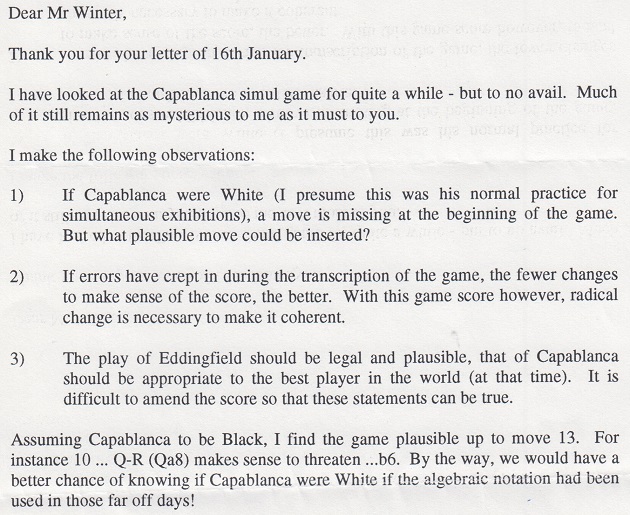
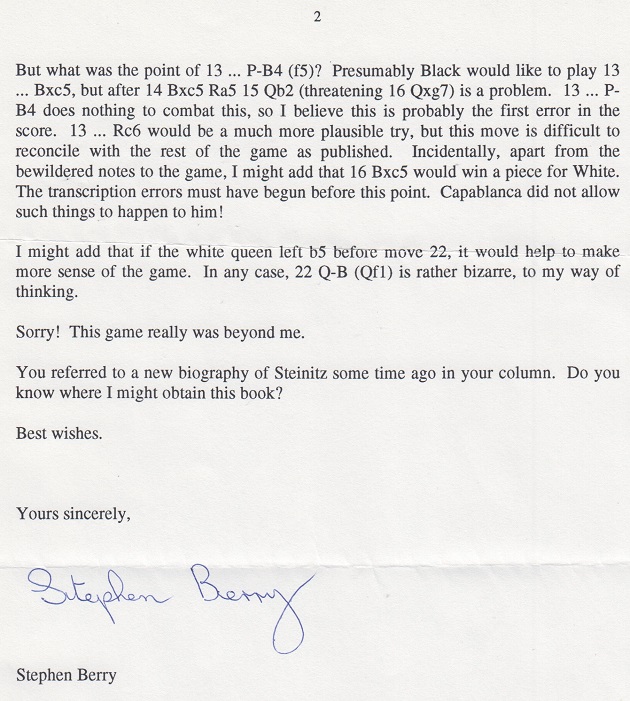
On 8 January 2001 we took the matter up in Richard Forster’s ‘Puzzles and Mysteries’ column at the Chess History Center (no longer available on-line), and Dan Heisman responded on 29 January 2001:
‘Well, with a little license and dozens of tries over an hour or so, I managed to come up with a score that makes some sense. But it assumes some rotten scorekeeping, or at least illegible handwriting (I would love to see a photo of the original score).
The first key is that ...f5 does not make sense, and later leads to all kinds of problems – I don’t think Capablanca dropped a piece as was possible in many of the actual lines. So what did Capablanca do? Rc6 is a nice move, and blocks all those Qxd7 and Qxb6 lines (and in descriptive, R-B6 could easily be misread as P-B5). But then why did Capablanca play Rxc2 leaving the N en prise? Answer: a pair of missing moves: ...h6 and Qd3 (this explains ...g5 later also and the lack of White back rank threats).
So now what about R-R5? That is probably Q-R5. That leaves one last puzzle – on Nc4, how come no Nxe3 next move? Because White was losing and not a good scorekeeper, he omitted Rd3 and Rcc2, the logical sequence.
So the game was possibly: 1 d4 d5 2 Nc3 Nf6 3 e3 c5 4 dxc5 e6 5 b4 a5 6 Ba3 axb4 7 Bxb4 Na6 8 Bb5+ Bd7 9 Bxa6 Rxa6 10 Qe2 Qa8 11 Nb5 Bxb5 12 Qxb5+ Nd7 13 a3 Rc6 14 Nf3 Bxc5 15 O-O h6 16 Qd3 O-O 17 Rfe1 Rfc8 18 Nd4 Bxd4 19 exd4 Rxc2 20 h3 Nb6 21 Re3 Qa4 22 f3 Qa6 23 Qf1 Qxf1+ 24 Kxf1 Rb2 25 Be7 Rcc2 26 Bh4 Nc4 27 Rd3 g5 resigns.
Now here’s the kicker: No matter what the correct score, in the late opening Capablanca missed a brilliancy: 11...Rxa2! 12 Nc7+ Kd8 13 Nxa8 Rxa1+ wins, as 14 Kd2? Ne4+ 15 Kd3 loses to Bb5+. Found by friend Fritz6, who aided in confirming the logic of Capa’s moves.’
In a post later the same day Richard Forster commented that 15...h6 looked a little artificial, and he added:
‘I suggest the transposition 15...O-O 16 Qd3 h6, as the pawn move makes more sense here (to prevent 17 Ng5 Nf6 18 Bc3 with some attack).’
The game-score thus tentatively proposed, incorporating that transposition, is 1 d4 d5 2 Nc3 Nf6 3 e3 c5 4 dxc5 e6 5 b4 a5 6 Ba3 axb4 7 Bxb4 Na6 8 Bb5+ Bd7 9 Bxa6 Rxa6 10 Qe2 Qa8 11 Nb5 Bxb5 12 Qxb5+ Nd7 13 a3 Rc6 14 Nf3 Bxc5 15 O-O O-O 16 Qd3 h6 17 Rfe1 Rfc8 18 Nd4 Bxd4 19 exd4 Rxc2 20 h3 Nb6 21 Re3 Qa4 22 f3 Qa6 23 Qf1 Qxf1+ 24 Kxf1 Rb2 25 Be7 Rcc2 26 Bh4 Nc4 27 Rd3 g5 28 White resigns.
11834. The conclusion of the 1987 world championship match
In addition to Leonard Barden’s detailed coverage of the final game of the Kasparov v Karpov title match in Seville on page 6 of the Guardian, 21 December 1987, the newspaper had this front-page report by Paul Ellman:
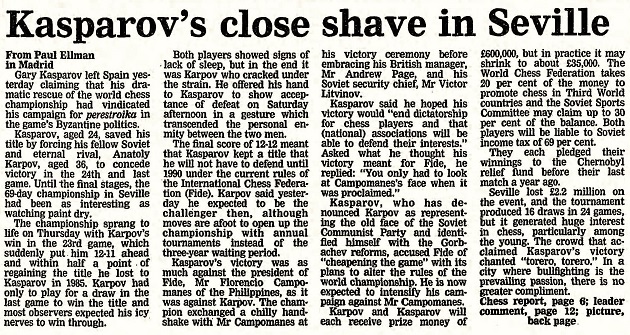
Page 12 of the same edition published an unsigned leading article:
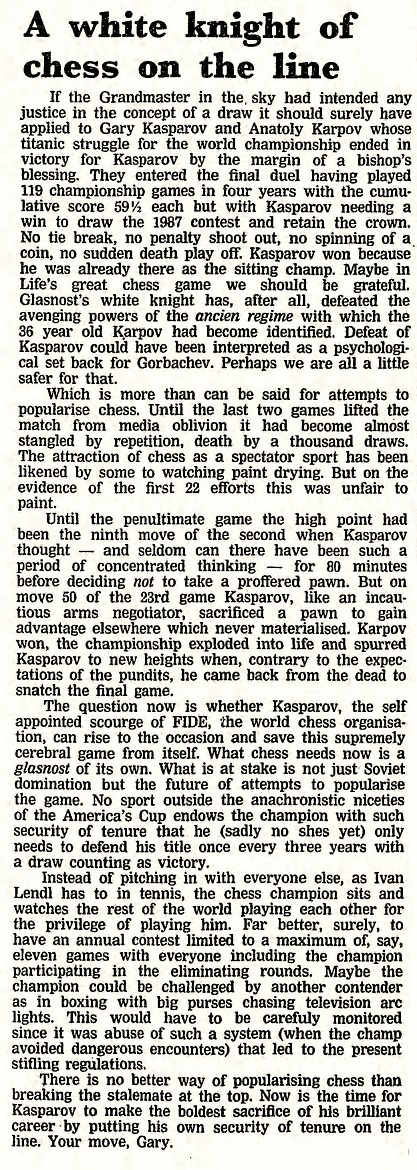
The items shown above prompted letters from George Botterill and Jon Levitt on page 8 of the Guardian, 24 December 1987:
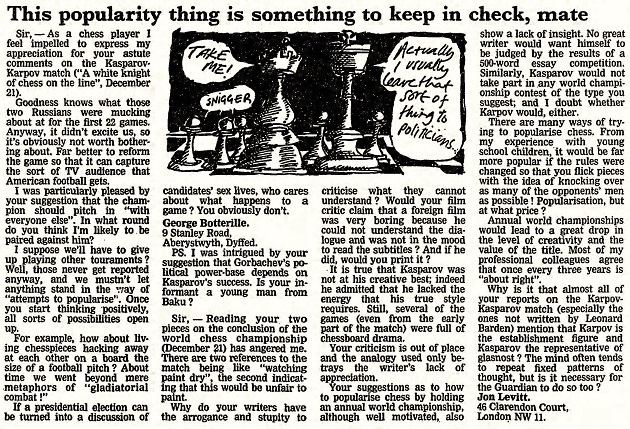
Paul Ellman, the Guardian’s correspondent in Spain, died on 24 February 1988, aged 43. His obituary was on page 35 of the 26 February 1988 edition.
11835. Rubinstein Junior
C.N. 909 (see pages 121-122 of Chess Explorations) reported on an interview with Akiba Rubinstein’s son Sammy conducted on our behalf by Karl De Smet (Brussels).
As mentioned in C.N. 1019, Mr De Smet subsequently (on 9 June 1985) sent us Paul Clément’s chess column in La Libre Belgique, 1 June 1985. It included a win by Sammy Rubinstein against Pierre Moulin (Championnat francophone de Belgique, Brussels, May 1985):
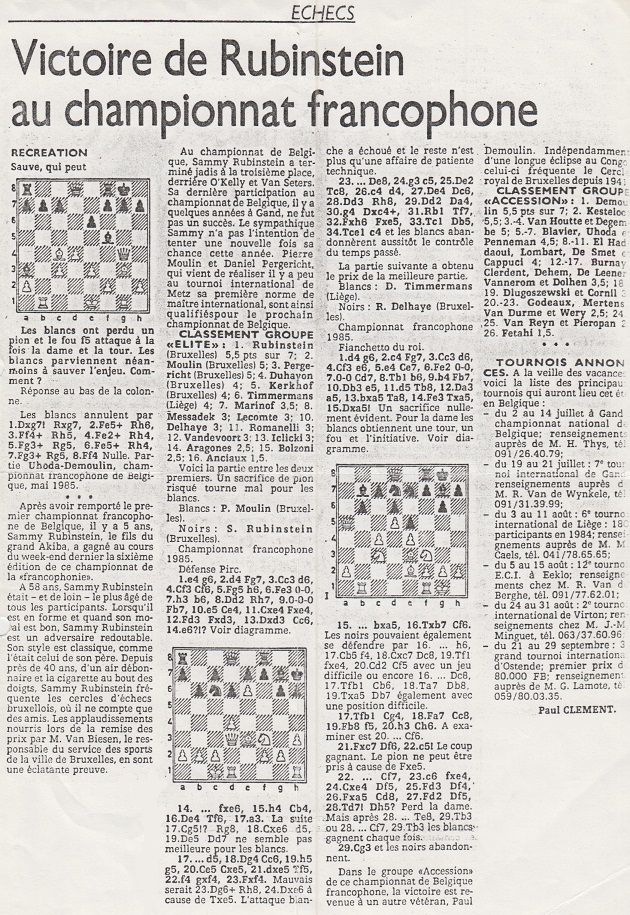
1 e4 g6 2 d4 Bg7 3 Nc3 d6 4 Nf3 Nf6 5 Bg5 h6 6 Be3 O-O 7 h3 b6 8 Qd2 Kh7 9 O-O-O Bb7 10 e5 Ne4 11 Nxe4 Bxe4 12 Bd3 Bxd3 13 Qxd3 Nc6 14 e6 fxe6 15 h4 Nb4 16 Qe4 Rf6 17 a3 d5 18 Qg4 Nc6 19 h5 g5 20 Ne5 Nxe5 21 dxe5 Rf5 22 f4 gxf4 23 Bxf4 Qe8 24 g3 c5 25 Qe2 Rc8 26 c4 d4 27 Qe4 Qc6 28 Qd3 Kh8 29 Qd2 Qa4 30 g4 Qxc4+ 31 Kb1 Rf7 32 Bxh6 Bxe5 33 Rc1 Qb5 34 Rce1 c4 and Black won.
Another victory by Sammy Rubinstein, against Gilles (Brussels, 1980), was given in C.N.s 1940 and 1961. See pages 66-67 of Kings, Commoners and Knaves.
11836. Letters from Edge to Fiske (C.N. 11784)
The series of letters from F.M. Edge to D.W. Fiske continues with the following, dated 30 August 1858:
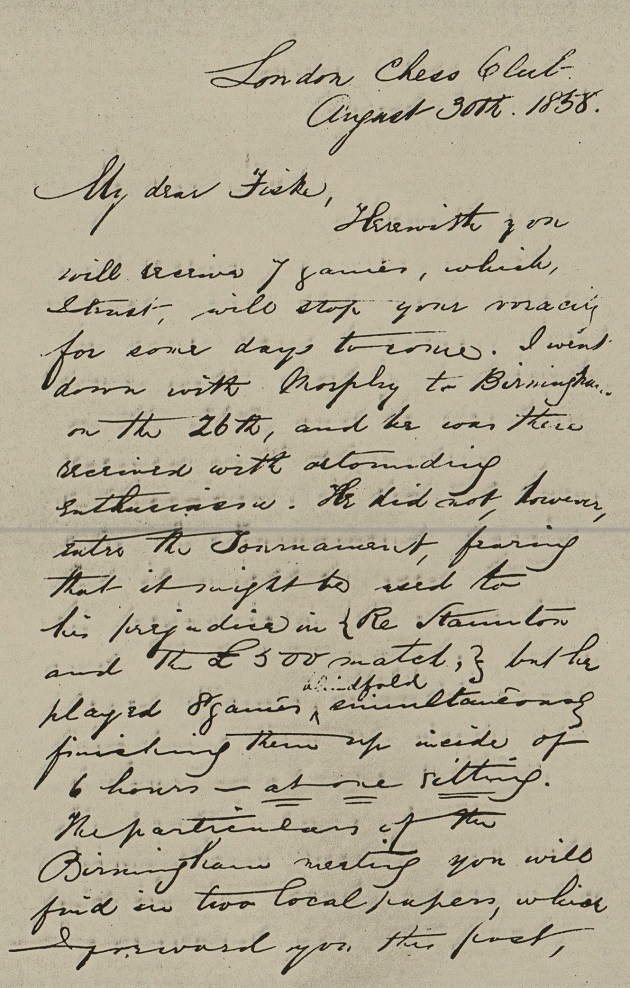

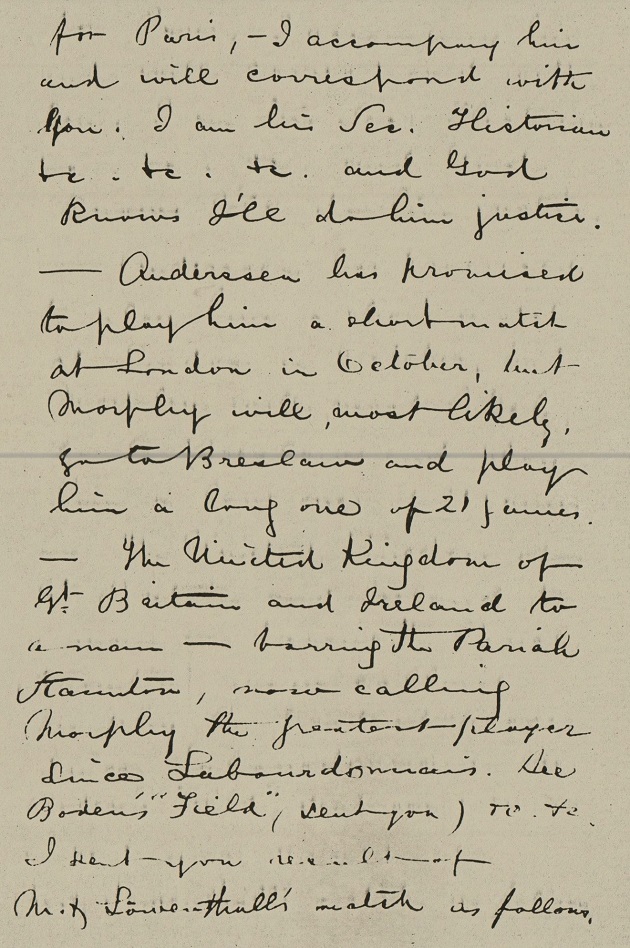
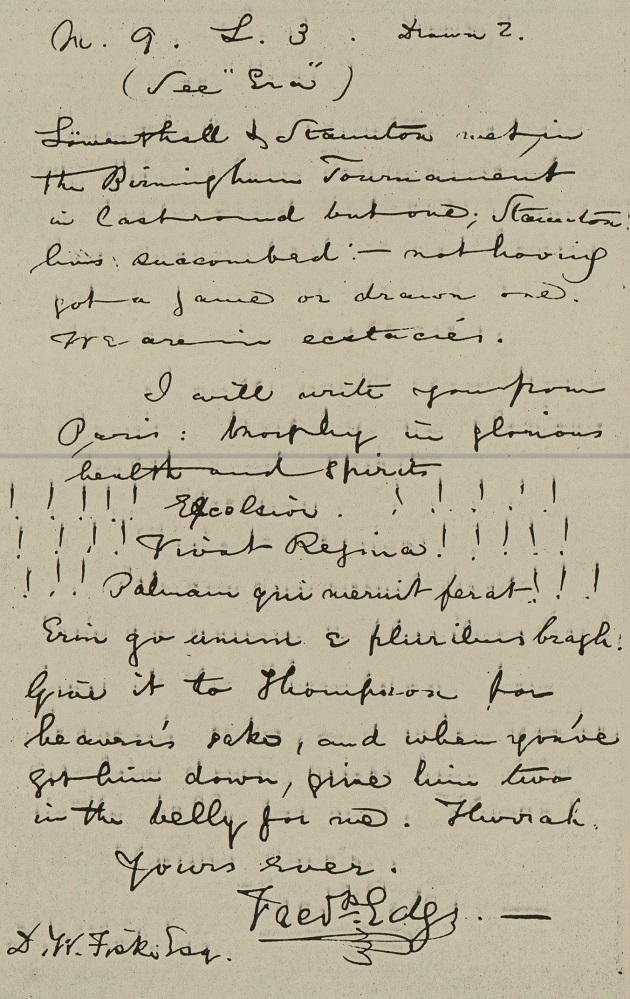
11837. Morphy and Edge
As a complement to Edge, Morphy and Staunton and Edge Letters to Fiske, we have been building up our latest feature article with extensive further material: A Debate on Staunton, Morphy and Edge.
Since the first appearance of the Oxford Companion to Chess by D. Hooper and K. Whyld, in 1984, particular attention has been paid to this section of the Paul Morphy entry on page 217:

In the revised edition of the Companion (1992) Edge had his own entry, and the highlighted quote was on page 120:

The full text of the Edge letter in question was published in C.N. 1358 (March-April 1987 issue), and our introduction commented:
The first thing to note is that, contrary to the impression given by the Companion, the letter is not addressed to Morphy himself, but to Fiske.
A transcription of the full text is given in the first two above-mentioned feature articles, and here we reproduce the relevant part:

‘I shall watch over Morphy until he leaves Europe, and when he leaves I can say – “What you are outside of chess, I have made you. Your tremendous laziness, but for me, would have obliterated all your acts. I have taken your hundreds of letters out of your pockets even, and answered them, because you would have made every man your enemy by not replying. I made you stay and play Anderssen, when you wanted to leave. I nursed you when ill, carrying you in my arms like a child. I have been a lover, a brother, a mother to you; I have made you an idol, a god – and now that you are gone, I never –– but I will not finish. I say this to you, Fiske, but I have said nothing of it in my book; there Morphy is all in all, the Alpha and Omega, the beginning and the end; all that is great, magnanimous, true, noble and sublime, and Morphy will not open its pages without a blush, or close them without a sigh. – Burn this letter, Fiske, and forget the contents. – Yrs. very truly
Fred’k Edge –’
11838. The debate
For the time being, we are still focusing on the Staunton-Morphy-Edge topic, and have just posted a supplementary article, as well as some additions to the debate article.
11839. G.H. Diggle
Our tribute to G.H. Diggle, who died aged 90 at Brighton General Hospital on 13 February 1993, was published on page 46 of CHESS, June 1993 and is also on pages 205-206 of Kings, Commoners and Knaves, as well as in C.N. 4337.
In a letter dated 3 March 1993, Anthony Diggle informed us of his father’s physical decline in the final weeks and added:
‘The flesh may have been weak, but the spirit was willing right to the end: he remained in full possession of his faculties until the last week, when exhaustion finally overtook him.
His letter to you on 4 February was, I believe, his last. As you know, never for one moment did he lose interest in any matter to do with chess. The acknowledgement of his last birthday in “Quotes and Queries”, BCM, December 1992 itself acknowledged his pointing out of an error in the Spassky-Fischer notes to Game 2 in their recent rematch, as no doubt you saw. Naturally he followed keenly the Short-Timman match, predicting correctly that Short would win.’
G.H. Diggle regularly sent us cuttings of the Daily Telegraph chess column of Nigel Short, whose writing he held in high regard.
Below are the last two letters that we received from G.H.D. The second one was written nine days before he died.
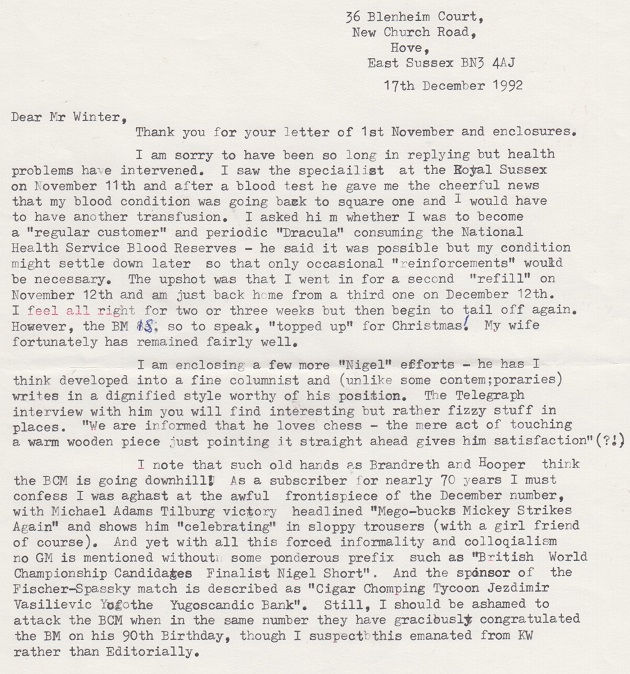
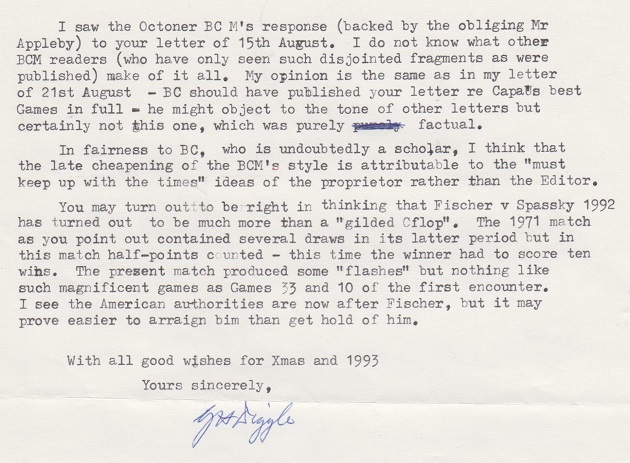
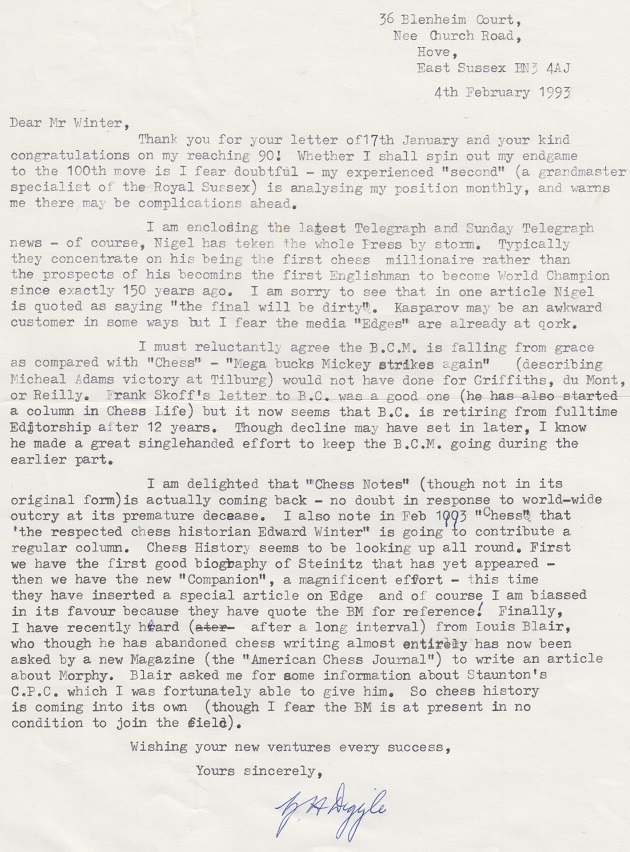
11840. Quiz questions
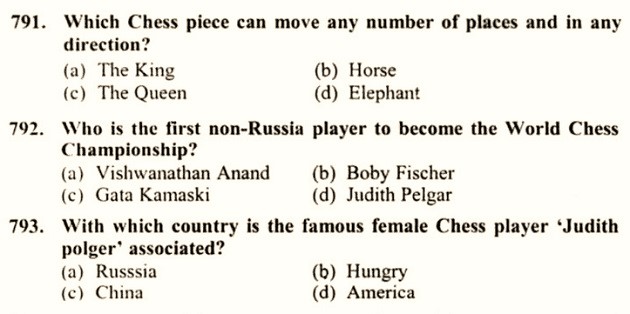
Source: Millennium Sports Quiz Book edited by Sachin Singhal (New Delhi, 2003). The chess questions (755-794) are on pages 78-82.
11841. A new Pillsbury monograph
C.N.’s references to new chess literature are largely confined nowadays to drawing attention to lesser-known publications. Our latest acquisition is Между Морфи и Фишером. Гарри Пильсбери by M. Sokolov (Moscow, 2020):
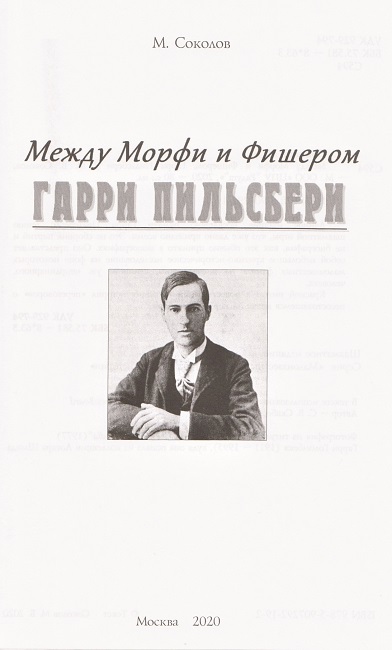
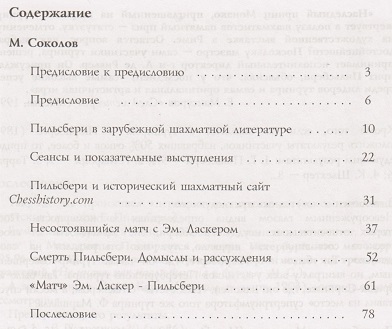
11842. William Davies Evans
From John Townsend (Wokingham, England):
‘The genealogical website Ancestry.com has recently put on-line many Welsh parish registers. In the baptism register of Stainton (modern spelling: Steynton), Pembrokeshire, is to be found an entry dated 21 September 1814 relating to the (adult) baptism of William Davies Evans. The entry notes that he was previously baptized privately at St Dogwells on 20 February 1790. His parents are entered as John and Mary Evans, the abode as Castlepill, his father’s occupation being farmer, and the baptism was conducted by William Lloyd, the curate of Burton.
The next entry in the Steynton register is the baptism on the same day, 21 September 1814, of a younger brother, Robert Joseph Evans, who was previously baptized privately on 26 February 1808. The other particulars are the same. Neither of the two entries gives a date of birth.’
11843. G.H. Diggle
Further material is regularly being added to our recent feature article G.H.D. Diggle, the Chess Badmaster. Among the latest additions is the following comment in a letter to us dated 17 March 1992, when he was aged 89:
‘Dr Nunn’s article in New in Chess [in the 1/1992 issue, concerning the 1991 English Championship] was one of the best I have read for a long time; he depicts the shoddy discomfort of the Knockout Tournament brilliantly and with a quiet underlying sarcasm.’

